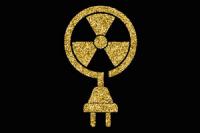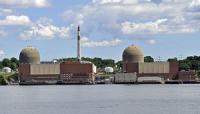-
System automatically detects cracks in steel components of nuclear power plants
The United States operates 99 commercial nuclear power plants, which account for about 20 percent of total U.S. electricity generation. Aging can result in cracking, fatigue, embrittlement of metal components, wear, erosion, corrosion and oxidation. Researchers have developed a new automated system which detects cracks in the steel components of nuclear power plants and has been shown to be more accurate than other automated systems.
-
-
Finding new clues for nuclear waste cleanup
Technetium-99 is a byproduct of plutonium weapons production and is considered a major U.S. challenge for environmental cleanup. At the Hanford Site nuclear complex in Washington state, there are about 2,000 pounds of the element dispersed within approximately 56 million gallons of nuclear waste in 177 storage tanks. The U.S. Department of Energy is in the process of building a waste treatment plant at Hanford to immobilize hazardous nuclear waste in glass. But researchers have been stymied because not all the technetium-99 is incorporated into the glass and volatilized gas must be recycled back into the melter system.
-
-
Identifying the right sites for storing radioactive waste
In 2008, a Swiss government agency identified six regions in Switzerland, approved by the Federal Council, which could be used to store radioactive waste. An EPFL research project has developed a detailed profile of the sites selected to store radioactive waste from Swiss nuclear power plants. The project helped identify the two sites that meet both safety and feasibility requirements.
-
-
U.K. nuclear safety regulations place too low a value on human life

New research has shown that the benchmark used by the U.K. Office for Nuclear Regulation for judging how much should be spent on nuclear safety has no basis in evidence and places insufficient value on human life. The review suggests it may need to be ten times higher — between £16 million and £22 million per life saved.
-
-
World leaders urged to take action to avert existential global risks
World leaders must do more to limit risk of global catastrophes, according to a report by Oxford academics. He academic define global catastrophe as a risk “where an adverse outcome would either annihilate Earth-originating intelligent life or permanently and drastically curtail its potential.” Three of the most pressing possible existential risks for humanity are pandemics, extreme climate change, and nuclear war.
-
-
New technique could lead to more efficient, safer uranium extraction
The separation of uranium, a key part of the nuclear fuel cycle, could potentially be done more safely and efficiently through a new technique developed by chemistry researchers at Oregon State University. The technique uses soap-like chemicals known as surfactants to extract uranium from an aqueous solution into a kerosene solution in the form of hollow clusters. Aside from fuel preparation, it may also find value in legacy waste treatment and for the cleanup of environmental contamination.
-
-
NY’s Indian Point nuclear plant to close after many “safety events”

New York’s Indian Point nuclear power plant will close by April 2021, Governor Andrew Cuomo said on Monday. “For fifteen years, I have been deeply concerned by the continuing safety violations at Indian Point, especially given its location in the largest and most densely populated metropolitan region in the country,” Cuomo said. “I am proud to have secured this agreement with Entergy [the plant’s operator] to responsibly close the facility fourteen years ahead of schedule, to protect the safety of all New Yorkers.”
-
-
Chemistry research breakthrough could improve nuclear waste recycling technologies
Researchers have taken a major step forward by describing the quantitative modelling of the electronic structure of a family of uranium nitride compounds – a process that could in the future help with nuclear waste recycling technologies. “In this nuclear age, there is a pressing need for improved extraction agents for nuclear waste separations and recycling technologies,” explained one of the researchers.
-
-
“Nightmare scenario”: Nuclear power plants vulnerable to hacking by terrorists
Security experts fear Fukushima-like disaster as terrorists use new technology to attempt attacks. The frequency and scope of cyberattacks on nuclear plants have increased dramatically, and experts say that a successful hack is now all but inevitable. They say that nuclear plant operators should focus more on preparing to contain and limit the damage when it does occur.
-
-
Safer, long-life nuclear reactors: Metal design may raise radiation resistance by 100 times
The big problem faced by metals bombarded with radiation at high temperatures—such as the metals that make up nuclear fuel cladding—is that they have a tendency to swell up significantly. They can even double in size. In findings that could change the way industries like nuclear energy and aerospace look for materials that can stand up to radiation exposure, researchers have discovered that metal alloys with three or more elements in equal concentrations can be remarkably resistant to radiation-induced swelling.
-
-
Future of nuclear energy unclear
Despite a turbulent history, the allure of nuclear energy — electricity production on a massive scale with minimal emissions — remains attractive. Its low emission rate is why the United Nations International Panel on Climate Change recommends doubling the world’s nuclear capacity by 2050. Yet the bulk of the 100 nuclear reactors currently operating in the U.S., which continue to produce about 20 percent of the nation’s energy, are reaching retirement age, and energy market forces don’t always favor nuclear.
-
-
Japan lifts Tsunami advisories
The Japanese authorities have lifted tsunami advisories issued after a powerful earthquake struck the northeast of the country early Tuesday, injuring twenty people. The magnitude 7.4 earthquake occurred at 5:59 a.m., local time, off the coast of Fukushima prefecture. There were no deaths or major damage, but transportation was disrupted and residents of low-lying areas were instructed to leave their homes for higher ground. The quake was felt in Tokyo, about 150 miles away. Nearly 16,000 people were killed and more than 2,500 remain missing from the magnitude 9.1 earthquake that struck Japan’s northeastern regions on 11 March 2011.
-
-
Feds sue to block acquisition of Dallas radioactive waste company
The U.S. Justice Department is suing to block a Salt Lake City-based company’s acquisition of Waste Control Specialists, the Dallas-based company that wants to expand the nuclear waste dump it operates in West Texas. If the $367 million merger with proposed buyer EnergySolutions goes through, it would “combine the two most significant competitors for the disposal of low level radioactive waste (LLRW) available to commercial customers in thirty-six states, the District of Columbia and Puerto Rico,” the Justice Department said.
-
-
Meeting global energy demands with nuclear power
An international team of scientists suggests that we must ramp up energy production by nuclear power if we are to succeed in warding off the worst effects of greenhouse gas emissions on climate change. The team suggests that beginning in 2020 we could achieve an annual electricity output of 20 terawatts without needing to develop carbon dioxide trapping and storage technology for the tens of billions of tons of emissions that would otherwise drive global warming to catastrophic levels.
-
-
Immobilizing radioactive waste in glass for millions of years
How do you handle nuclear waste that will be radioactive for millions of years, keeping it from harming people and the environment? It is not easy, but researchers have discovered ways to immobilize such waste – the offshoot of decades of nuclear weapons production – in glass and ceramics.
-
More headlines
The long view
Smaller Nuclear Reactors Spark Renewed Interest in a Once-Shunned Energy Source
In the past two years, half the states have taken action to promote nuclear power, from creating nuclear task forces to integrating nuclear into long-term energy plans.
Keeping the Lights on with Nuclear Waste: Radiochemistry Transforms Nuclear Waste into Strategic Materials
How UNLV radiochemistry is pioneering the future of energy in the Southwest by salvaging strategic materials from nuclear dumps –and making it safe.
Model Predicts Long-Term Effects of Nuclear Waste on Underground Disposal Systems
The simulations matched results from an underground lab experiment in Switzerland, suggesting modeling could be used to validate the safety of nuclear disposal sites.
